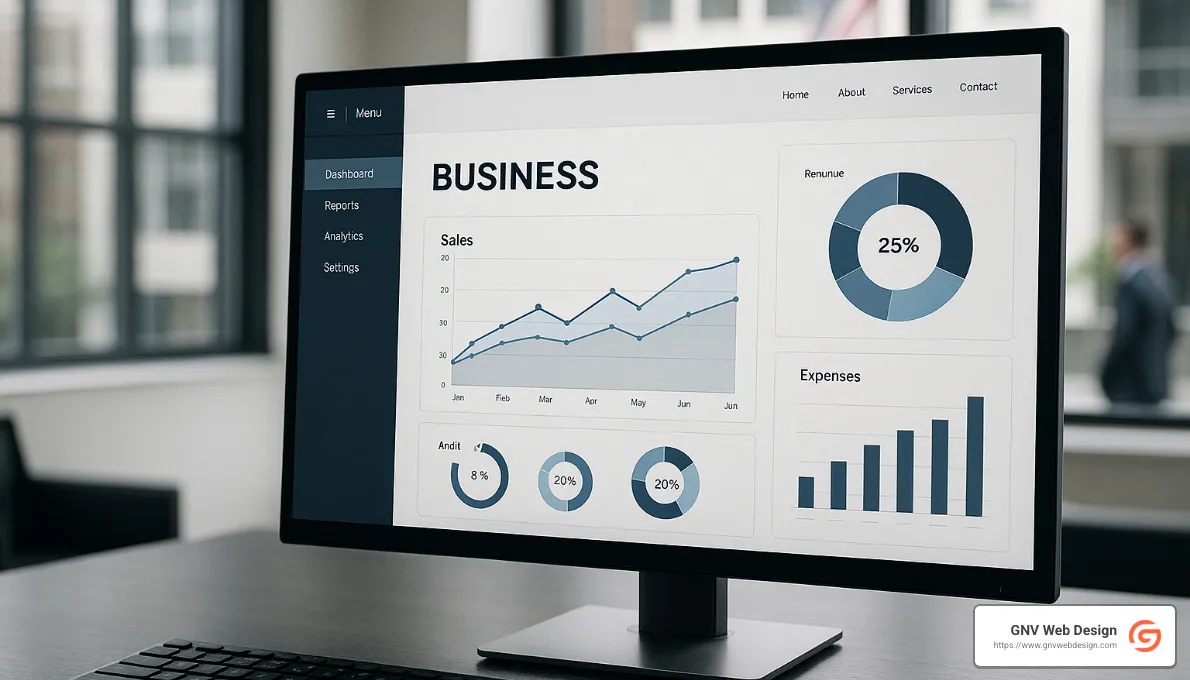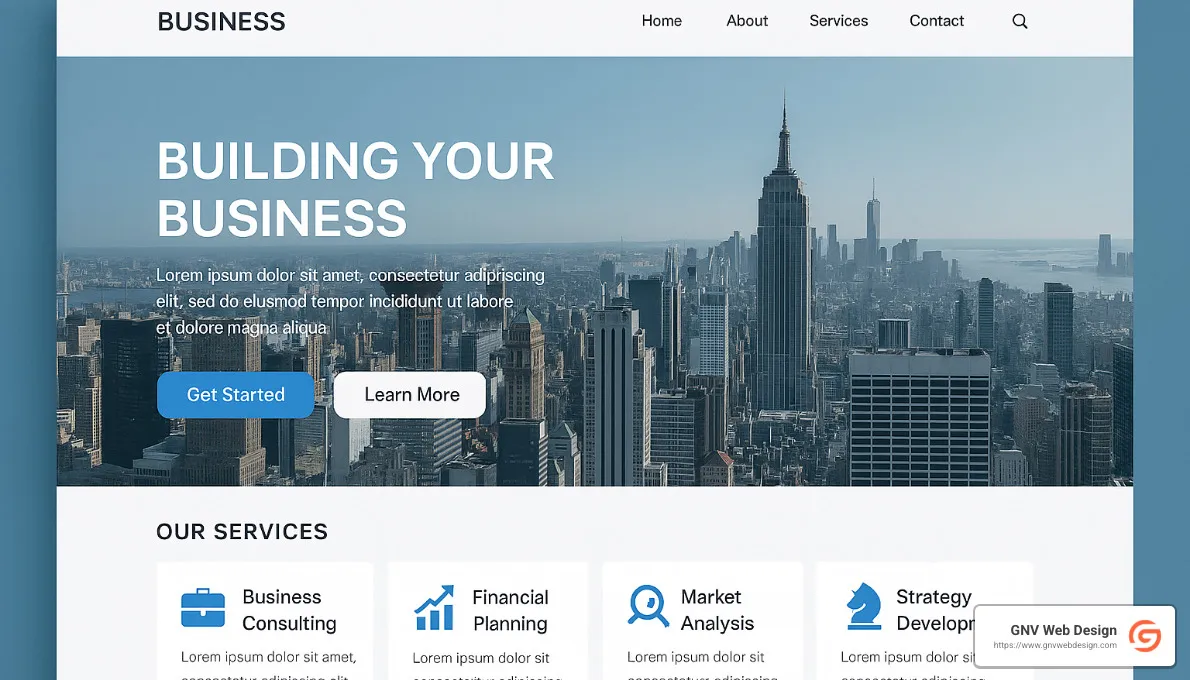Key Components of Effective Business Website Design
Creating a website that is both visually appealing and highly functional involves several crucial components. Let's dig into some of the most important elements that make a business website design truly stand out.
User-Friendly Navigation in Business Website Design
A website's navigation is like a road map guiding users to their destination. Intuitive menus and clear site architecture improve user experience by making it easy for visitors to find what they're looking for. As one might say, "If users can't find it, they can't buy it."
- Intuitive Menus: Use simple, descriptive labels for menu items. Avoid jargon.
- Site Architecture: Organize content logically. Group related pages together.
- Easy Navigation: Ensure visitors can reach key pages in a few clicks.
Responsive and Mobile-Friendly Design for Businesses
Every business website must be mobile-friendly. With a growing number of users accessing websites via smartphones and tablets, responsive design is non-negotiable.
- Mobile Optimization: Ensure your site adjusts automatically to different screen sizes.
- Responsive Layouts: Use flexible grids and layouts.
- Device Compatibility: Test your site on various devices to ensure a seamless experience.
Clear and Compelling Calls-to-Action
Calls-to-action (CTAs) are essential for guiding user actions and increasing engagement. They should be clear, concise, and compelling.
- CTAs: Use action-oriented language to prompt user interaction.
- Conversion Elements: Place CTAs strategically on pages to guide the visitor journey.
- Increasing Engagement: Regularly test and update CTAs to improve conversion rates.
Optimizing Your Business Website for Search Engines

Imagine creating the most beautiful, user-friendly, and intuitive website for your business—only to realize no one can find it. That's where SEO (Search Engine Optimization) steps in. Optimizing your business website design for search engines ensures it's visible to potential customers, driving more traffic right to your digital doorstep.
Following SEO best practices can significantly boost your website's ranking on platforms like Google. Higher visibility means more organic traffic, increased engagement, and improved chances of turning visitors into loyal customers. Let's explore the essential ways you can optimize your website effectively.
Conducting Keyword Research for Business Website Design
Effective SEO starts with smart keyword research. Keywords are simply the words or phrases your potential customers type into search engines when looking for products or services like yours.
To target the right keywords, you'll want to get into the minds of your customers. What terms might they use when searching for your offerings? Thinking about search intent—the reason behind someone's search—helps you create content that truly matches their needs.
You don't have to guess these keywords. There are plenty of helpful tools like Google's Keyword Planner, SEMrush, and Ahrefs to identify high-volume, relevant terms. Once you've found a few great keywords, naturally sprinkle them throughout your content to boost your site's chances of being found.
On-Page SEO Techniques
After you've nailed down your keywords, it's time to roll up your sleeves and optimize your web pages. This process, called on-page SEO, helps search engines clearly understand what your content is about.
Begin with your title tags. These short, clickable headlines on search engine results pages should include your primary keyword. Keep them concise but engaging to encourage clicks.
Next come your meta descriptions. Think of these as mini ads for your content. A compelling meta description draws people in and entices them to click. Be sure to include your target keyword naturally.
When writing content, break it up into clear sections with header tags (H1, H2, H3). Headers make it easier for readers—and search engines—to digest your content. Your main heading (H1) should include your primary keyword, with subheadings (H2, H3) organized logically.
Images also deserve attention. Make sure each picture includes descriptive alt text. Alt text improves both SEO and accessibility by clearly describing images for those unable to see them.
And don't forget to keep your URLs clean and simple. Rather than a messy string of letters and numbers, create a readable, keyword-rich URL structure that clearly indicates the content of the page.
If you'd like a deeper dive into SEO best practices, check out Google's SEO Starter Guide.
Creating High-Quality Content
You've probably heard the phrase "content is king," but it's more accurate to say high-quality content is king. Creating valuable, engaging content that genuinely helps your audience is one of the most powerful ways to boost your SEO.
Good content answers questions, solves problems, or fulfills a need. It isn't just about keywords—it's about providing genuine value. To keep visitors engaged, include multimedia elements like images, videos, and infographics where appropriate.
An ongoing content strategy plays a vital role in this effort. Regularly publish fresh content like helpful blog posts, insightful articles, or practical guides that your audience finds interesting. Frequent, relevant updates signal to search engines that your website is active and valuable, improving your chances of ranking higher in search results.
By thoughtfully optimizing your site's SEO and making high-quality content a priority, you'll not only draw more visitors—you'll also build better connections with them, turning casual readers into loyal customers.
Choosing the Right Platform for Your Business Website

Choosing the right platform is essential for your business website's success. It can affect everything from design flexibility to scalability.
Evaluating Your Business Needs
Before selecting a platform, evaluate your business's specific requirements.
- Budget Considerations: Determine how much you're willing to invest.
- Functionality Requirements: Identify must-have features for your website.
- Technical Skills: Consider whether you need a no-code solution.
- Future Growth: Choose a platform that can grow with your business.
Comparing Popular Business Website Builders
Several website builders are popular among businesses for their ease of use and features. Here's a quick comparison:
- Wix: Intuitive drag-and-drop editor, excellent for beginners.
- WordPress: Highly customizable with thousands of plugins.
- Squarespace: Offers beautiful design templates with integrated SEO tools.
- Shopify: Ideal for eCommerce with robust sales features.
For a detailed guide on choosing a website builder, visit TechRadar's Guide.
Custom Development vs. Pre-built Templates
Deciding between custom development and pre-built templates depends on your needs.
- Pros and Cons: Custom development offers more flexibility but can be costly. Templates are budget-friendly but less unique.
- Level of Customization: Consider how much personalization you need.
- Time to Market: Templates can be quicker to launch.
- Cost Implications: Weigh the costs of development versus template licensing.
Incorporating Essential Business Tools and Features
A website should not only look good but also function effectively with integrated business tools.
eCommerce Features for Business Websites
For businesses selling products online, eCommerce features are crucial.
- Product Listings: Showcase products with detailed descriptions and images.
- Shopping Carts: Allow customers to easily add and remove items.
- Payment Gateways: Ensure secure and diverse payment options.
- Secure Transactions: Protect customer data with SSL certificates.
Integrating Scheduling and Booking Tools
For service-based businesses, scheduling tools improve customer convenience.
- Appointment Scheduling: Allow clients to book services directly.
- Service Bookings: Integrate with calendars for real-time availability.
- Calendar Integration: Sync appointments with popular calendar apps.
Utilizing Analytics and CRM Tools
Analytics and CRM tools help you understand visitor behavior and improve customer relationships.
- Tracking Visitor Behavior: Use tools like Google Analytics for insights.
- Converting Leads: Capture and nurture leads effectively.
- Customer Relationship Management: Manage customer interactions and data.
- Data-Driven Decisions: Use analytics to inform business strategies.
For more on essential features, explore Top 10 Small Business Website Features.
Enhancing Accessibility and Inclusivity in Business Website Design
Creating an accessible and inclusive website is not just a legal requirement but also a business imperative.
Implementing Accessible Design Practices
Accessible design ensures all users, including those with disabilities, can steer your site.
- Alt Text: Describe images for screen readers.
- Keyboard Navigation: Allow navigation without a mouse.
- Readable Fonts: Use clear, legible typography.
- Color Contrast: Ensure text is readable against background colors.
- Subtitles for Videos: Provide captions for audio content.
For standards, refer to Web Accessibility Standards.
Importance of Inclusive Design for Your Business
Inclusive design expands your market reach and builds trust.
- Legal Compliance: Avoid lawsuits by meeting ADA standards.
- Brand Reputation: Show commitment to inclusivity and diversity.
- Customer Trust: Demonstrates that you value all customers.
- Expanded Market Reach: Tap into a broader audience by being accessible.
Leveraging AI Tools to Improve Your Business Website
Building a successful website isn't just about great visuals and SEO—it's also about using the right tools to boost your efficiency and user experience. Artificial intelligence (AI) is becoming a game-changer in business website design, offering smart solutions to help you save time and better serve your customers. Let's explore how AI can lift your website's design and performance.
AI in Business Website Design
Gone are the days when creating a professional website meant weeks of tedious work. Today, AI-powered website builders can help you get online quickly and effortlessly. These clever AI builders generate designs custom to your brand, industry, and audience, giving you a beautiful website in a fraction of the time.
Not the greatest designer? No worries—AI-driven design suggestions are here to help. These smart tools recommend appealing layouts, color schemes, and images that resonate with your visitors. They're like having a talented, ever-helpful design assistant by your side (minus the coffee breaks).
AI also excels at handling repetitive tasks. It can automatically update sections of your site, resize images, or even create engaging content like blog outlines and product descriptions. This automation of tasks means you spend less time managing your website and more time running your business.
Integrating AI into your business website design leads to significant efficiency improvements. You'll reduce the hours (and headaches!) spent on routine updates and edits, freeing you up to focus on connecting with customers and growing your business.
Enhancing User Experience with AI
AI's talents don't stop at design—it also plays a big role in enhancing your visitors' experience. One perfect example is using chatbots for customer service. These friendly virtual assistants provide instant, 24/7 support to your visitors, answering common questions, troubleshooting issues, and even guiding them through purchases.
Your customers aren't all the same, so why should their website experiences be identical? AI helps you deliver personalized recommendations based on each visitor's preferences and browsing history. Imagine your website serving content, products, or offers custom specifically to each individual. Talk about rolling out the virtual red carpet!
AI can also make your site more engaging with interactive elements. These could be quizzes, custom calculators, or custom videos—fun, interactive features that keep visitors coming back.
By tapping into the power of AI, you can create a smarter, more efficient, and more intuitive business website. After all, technology is here to make our lives easier—so why not use it to give your customers a smoother, more satisfying online experience?
Common Mistakes to Avoid in Business Website Design
Creating your business website is an exciting step, but sometimes it's easy to stumble into common pitfalls. Let's look at some frequent missteps, so you can steer clear and ensure your business website design is effective, inviting, and successful.
Overcomplicating the Business Website Design
It might be tempting to impress visitors with fancy animations, flashy graphics, and elaborate layouts. But when it comes to your website, simplicity often wins.
Visitors are there because they want something—products, services, or information. If your site is cluttered or confusing, they'll quickly click away. Prioritize simplicity over complexity: keep designs clean, straightforward, and easy to steer.
Always focus on user experience by thinking from your visitor's perspective. Can they easily find what they want? Is the site's structure intuitive and clear? Less clutter means happier visitors—and happier visitors can become loyal customers!
Neglecting Mobile Users
Did you know that more than half of all web traffic now comes from mobile devices? If your website doesn't play nicely with smartphones and tablets, you're losing customers before they ever see your offerings.
Mobile-first design isn't just a buzzword—it's essential. Ensure your site looks great and works smoothly on smaller screens. Test regularly for responsive issues to make sure nothing important gets hidden, distorted, or difficult to tap.
Keep up-to-date with mobile traffic stats and trends to understand how your audience browses. If your business website design ignores mobile users, you're essentially closing your door on potential customers. Don't leave them standing outside—invite them in!
Ignoring SEO Best Practices
You could have the most beautiful website in the world, but if search engines can't find it, neither will your customers. Ignoring SEO best practices can severely limit your site's visibility and growth potential.
Pay careful attention to your site's SEO. Strategically place target keywords throughout your pages (naturally, not awkwardly!). Fix any technical SEO issues right away—such as broken links, missing meta descriptions, or slow load times—to keep both visitors and search engines happy.
And remember, Google's rules aren't just guidelines: violating them can lead to potential penalties, hurting your site's ranking and your business's online reputation. Stick to the rules—your website (and your customers) will thank you.
Frequently Asked Questions about Business Website Design
How Much Does It Cost to Build a Business Website?
Ah, the million-dollar question—well, hopefully not literally! The cost of building a business website design can vary widely. Several factors come into play, including the complexity of the design, the features you want, and the platform you choose.
If you're looking for something straightforward and budget-friendly, a DIY approach through a website builder like Wix or Squarespace can be quite affordable. However, if your business requires custom functionality, professional design, or advanced integrations, hiring a professional web design company (like us here at GNV Web Design) would be your best bet.
Aside from the initial build, remember to plan for ongoing expenses such as hosting, regular updates, SEO (search engine optimization), and marketing efforts. Budgeting for these will ensure your website stays in tip-top shape and continues to attract customers effectively.
Can I Create a Business Website Without Knowing How to Code?
Absolutely! Gone are the days when you had to be a coding wizard to build your own website. Today, no-code platforms have made it easy for anyone—even folks who find technology a bit intimidating—to create a professional-looking business website design.
Platforms like Wix, Squarespace, and Shopify offer user-friendly builders with intuitive drag-and-drop interfaces. They let you easily add pages, images, text, and even advanced features like online stores or booking calendars without typing a single line of code.
However, if you find yourself overwhelmed or simply prefer to leave the technical stuff to someone else, partnering with web design professionals like GNV Web Design can give you peace of mind. Plus, you'll have experts by your side, offering comprehensive support, unlimited edits, and timely responses. Win-win!
Should I Hire a Professional or Use a Website Builder for My Business Website Design?
Great question—and honestly, it depends! Both options can lead to fantastic results, but understand what suits your business best.
A professional business website design service, like GNV Web Design, offers customized solutions custom specifically to your needs. You'll have greater flexibility, unique branding opportunities, and access to hands-on expertise for SEO optimization, site performance, and complex integrations.
On the other hand, website builders such as Wix or Squarespace provide simplicity, affordability, and ease-of-use. These are great options if you're just starting out, have a limited budget, or prefer a DIY approach.
When deciding, consider your budget, the complexity of your vision, your technical skills, and your available time. If you'd rather focus on running your business, hiring professionals ensures a stress-free experience and high-quality outcomes.
Still not sure which way to go? It never hurts to chat with an expert. Why not reach out and see how we can help you bring your business website vision to life?
Conclusion

A well-designed business website is a cornerstone of modern business strategy. It not only improves your brand image but also drives customer engagement and sales. By focusing on strategic design elements and avoiding common pitfalls, you can create a website that truly works for your business.
For more insights on changing your small business through effective web design, visit Well-Designed Website: Transform Your Small Business.
Consider partnering with experts like GNV Web Design to bring your vision to life. With our comprehensive support and expertise, your business website can become a powerful tool for growth.
Conclusion
[IMAGE] of successful business website; call to action; summary of key points; importance of strategic approach
[Internal link: Well-Designed Website: Transform Your Small Business]
Consider partnering with experts like GNV Web Design to bring your vision to life.
More info about our services




